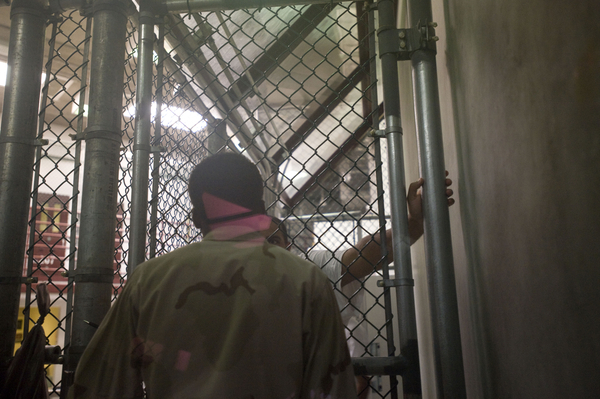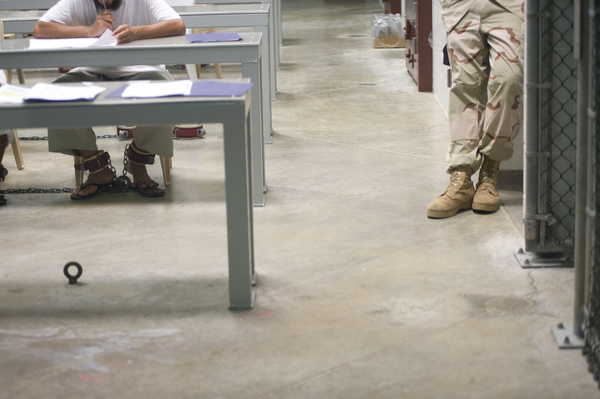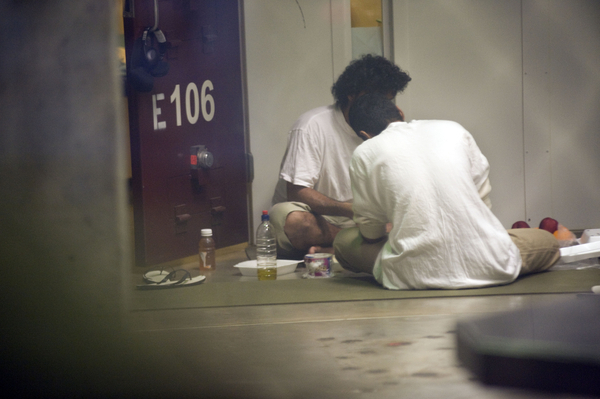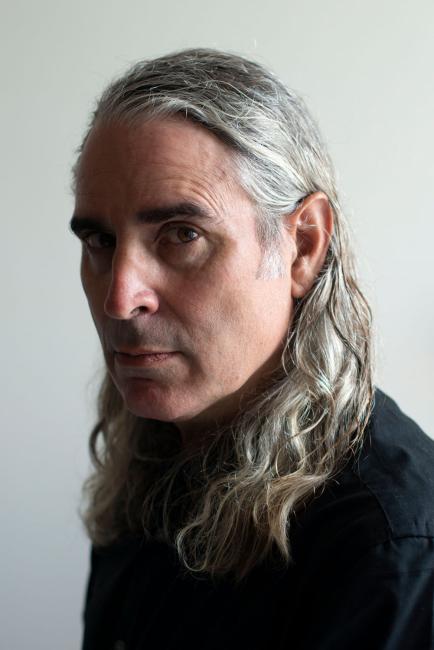
Shooting Gitmo: Day One

A detainee having a discussion with a guard in Camp 6 at the Guantánamo Bay Detention Facility. (Louie Palu / ZUMA Press)
It is after 1 A.M. and the end of the first day of shooting in the camps. My Operational Security (OPSEC) Review took four hours and two photographers are still having their photographs reviewed by military officials. This is the process at the end of each day: your work is scrutinized and if it does not meet the guidelines it is permanently deleted from your camera’s memory cards. The main issue is showing the face of any of the detainees as well as some security features of the facility and base. I lost a few photos I would have liked to keep, but then anyone who has worked here knows that you are going to lose photos during the review.
Sometimes you take photographs which land in a gray area of the rules by way of focus and angle. In the end you try to argue for and keep as many images as possible. One photographer lost half of his pictures. It is a complex process, depending on where you are in the camps, detainees can appear without warning escorted by guards in some sections. In other areas, detainees need only complain to the guards and the photography is stopped. Some detainees smile and wave at the camera and try to communicate with us, but we are not permitted to communicate with them. Since my first tour here in 2007, the detainees seem more empowered. On my first two tours the detainees never complained about the media, now they need only to wave us off or cause a commotion and we are whisked away to keep the peace. Some of the access is blocked by the military, and some photography is made difficult or blocked by the detainees as well. Some days you can’t win.
Since I have photographed this facility extensively I am always looking for something new, something I have not witnessed or noticed while competing with three other professional photographers who are trying to outdo me as I try to outdo them. Sometimes I let the other three photographers walk ahead of me so I shoot something behind them that they did not notice and are too focused on what is ahead of them to look back at what I am doing. We can’t roam on our own here and are always escorted by Public Affairs Officers (PAO). When in the camps we are also joined by several guards, many of whose identities we cannot show. We sometimes shoot through several fences, including tinted windows, making focusing and exposure a nightmare. All the while making sure we follow the list of rules and guidelines.

A detainee reading documents during a class on an unknown subject in Camp 6. (Louie Palu / ZUMA Press)

Detainees sit outside their cells for a meal in Camp 6. (Louie Palu / ZUMA Press)
One of the new things I noticed today was that the US flags which used to hang on the front of just about every guard tower in Guantánamo had been removed. Also, the detainees in all the camps are being given more and more outdoor recreation facilities, even in the maximum security camps. One of these is Camp 6, in which I saw detainees in a class scenario with a teacher, in an unknown lesson, although their feet were shackled to the floor. Others were in an art class and a few ate together communally. From my first tour to this one, I can see the direction things seem to be steering; it looks to be an attempt to stimulate their social and mental capacity after years of detention and isolation—though some military personnel still speak of assaults on guards.
Another day of photography lies ahead. Today, while eating breakfast, I watched President Obama on television visiting US troops in Afghanistan. I wonder if he would ever visit Guantánamo Bay.

